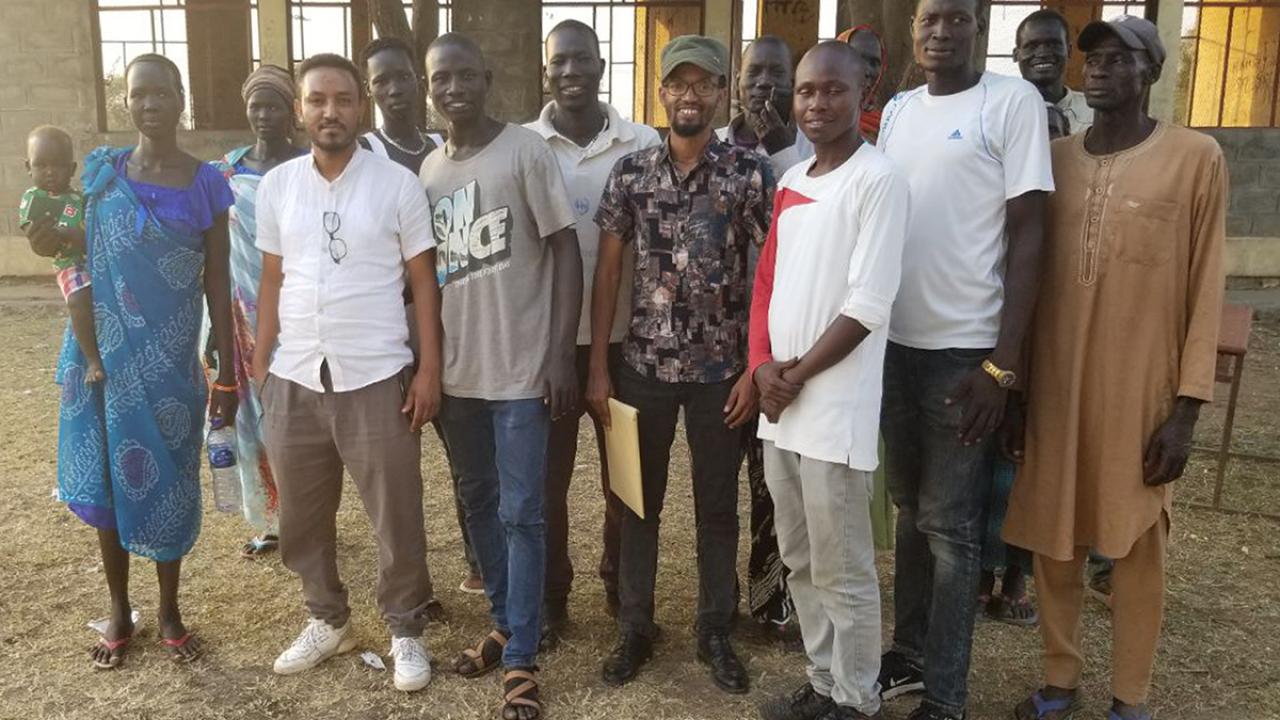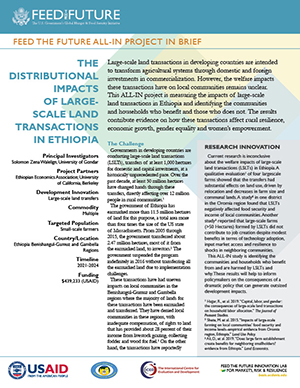
Large-scale land transactions in developing countries are intended to transform agricultural systems through domestic and foreign investments in commercialization. However, the welfare impacts these transactions have on local communities remains unclear. This ALL-IN project is measuring the impacts of large-scale land transactions in Ethiopia and identifying the communities and households who benefit and those who does not. The results contribute evidence on how these transactions affect rural resilience, economic growth, gender equality and women’s empowerment.
Project Overview
Principal Investigator: Solomon Zena Walelign, University of Gondar
Project Partners: Ethiopian Economics Association; University of California, Berkeley
Development Innovation: Large-scale land transfers
Commodity: Multiple
Targeted Population: Small-scale farmers
Country/Location: Ethiopia Benishangul-Gumuz and Gambella Regions
Timeline: 2021-2024
Funding: $439,233 (USAID)
The Challenge
Governments in developing countries are conducting large-scale land transactions (LSLTs), transfers of at least 1,000 hectares for domestic and capital investments, at a historically unprecedented pace. Over the past decade, at least 50 million hectares have changed hands through these transfers, directly affecting over 12 million people in rural communities.[1]
The government of Ethiopia has earmarked more than 11.5 million hectares of land for this purpose, a total area more than four times the size of the US state of Massachusetts. From 2005 through 2015, the government transferred about 2.47 million hectares, most of it from the earmarked land, to investors.[2] The government suspended the program indefinitely in 2016 without transferring all the earmarked land due to implementation challenges.
These transactions have had uneven impacts on local communities in the Benishangul-Gumuz and Gambella regions where the majority of lands for these transactions have been earmarked and transferred. They have denied local communities in these regions, with inadequate compensation, of rights to land that has provided about 28 percent of their income from livestock grazing, collecting fodder and wood for fuel.[3] On the other hand, the transactions have reportedly generated alternative incomes, including jobs and higher agricultural production through technology and knowledge transfers.
The broader impacts of LSLTs are unclear, as well as what communities and households are most affected. LSLTs may generate growth by enabling business development, which expands access to markets and services and increases jobs and entrepreneurship. It could also be that LSLTs weaken resilience among people and systems by taking away from risk management strategies, inhibiting adaptations to shocks and degrading natural resources.

Research Design
This ALL-IN project led from the University of Gondar is testing the impacts of LSLTs on rural communities in Ethiopia’s Benishangul-Gumuz and Gambella regions. In particular, the research is identifying who benefits from these transfers and who does not, with a focus on the causes of those varying impacts. The study measures those impacts based on the difference in the amount of land earmarked and transferred land across districts in the regions specifically.
The Ethiopian government targeted and earmarked land in a total of eight districts in the Benishangul-Gumuz region and ten in the Gambella region for agricultural investment through LSLTs. Actual transfers occurred in four of districts in Benishangul-Gumuz and in six districts in Gambella. Communities within these regions are very similar in terms of the religious and ethnic composition of communities as well as environmental qualities like rainfall patterns and soil qualities. Most of the communities in both regions farm, raise livestock or both.
This difference between where LSLTs have taken place and where they have not makes it possible to measure a number of impacts for individual households. These impacts include local economic activities and labor markets, education, employment, living standards, migration and whether LSLTs empower or disempower vulnerable social groups like ethnic minorities and women.
In both regions, the study includes a randomly selected sample of 1,000 households from areas that experienced LSLTs and 1,000 households in areas that did not for a total of 4,000 participants. The research team is also measuring any spillover impacts from communities affected by LSLTs and nearby communities.
Development Impact
Agricultural ministries across the global south are including LSLTs in their long-term strategic plans as a way to accelerate agricultural commercialization. In Ethiopia, LSLTs were intensified during the five-year Growth and Transformation Plan that seeks to improve food security, create jobs, accumulate capital and promote exports by attracting domestic and international investments. This ALL-IN project will build evidence on how LSLTs contribute to or detract from these and other goals.
The project directly contributes to the Feed the Future objectives of inclusive sustainable agriculture-led economic growth, strengthened resilience among people and systems, as well as the cross-cutting intermediate result of increased gender equality and women’s empowerment. The project addresses USAID Ethiopia’s Country Development Cooperation Strategy (CDCS) Development Objective 3 by investigating how LSLTs and private sector-led economic growth interact with agricultural transformation and market inclusivity.
[1] Davis, K. F., et al. 2014. “Land grabbing: A preliminary quantification of economic impacts on rural livelihoods.” Population and environment.
[2] Teklemariam, D., et al. 2015. “Transnational land deals: Towards an inclusive land governance framework.” Land Use Policy.
[3] Angelsen, A., et al. 2014. “Environmental income and rural livelihoods: a global-comparative analysis.” World Development.
This report is made possible by the generous support of the American people through the United States Agency for International Development (USAID) cooperative agreement 7200AA19LE00004. The contents are the responsibility of the Feed the Future Innovation Lab for Markets, Risk and Resilience and do not necessarily reflect the views of USAID or the United States Government.
